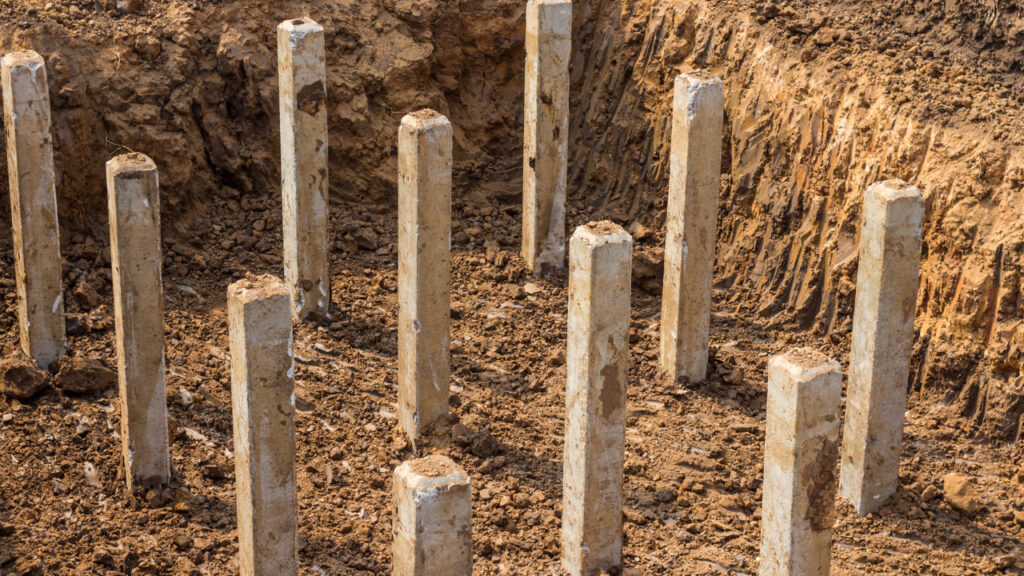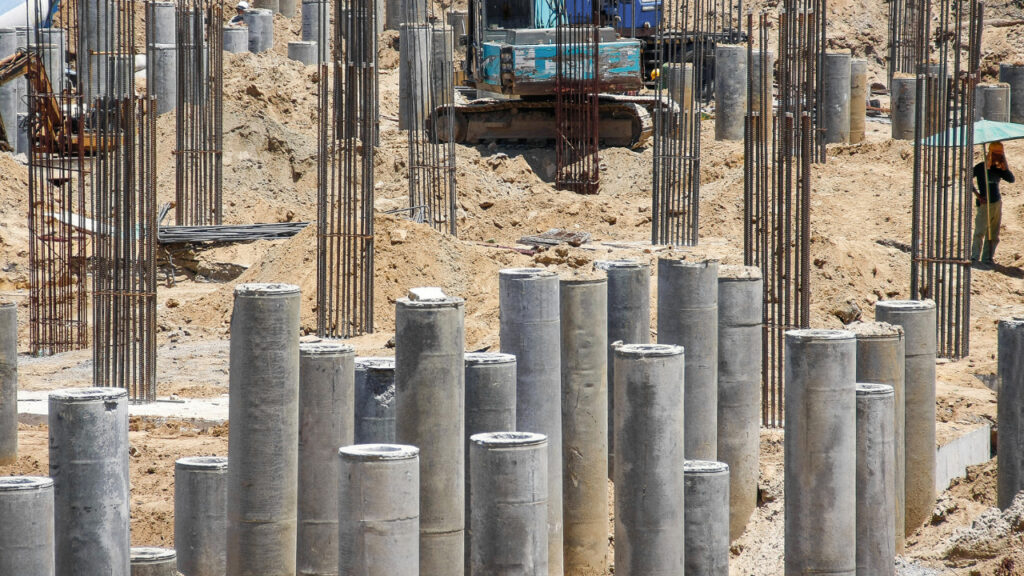Pile Foundations in Construction: Exploring Beyond Strength
Are you looking to choose the best foundation for your building?
Well, that’s all of us. Whether choosing commercial or residential foundations, there are different foundation options available for you to choose from. However, you can’t blindly choose one as every building has its specific foundation requirements. For instance, if you are going to build a structure in a place where the soil is marshy, a pile foundation might be the only option you have.
Similarly, not a single foundation type goes well with different construction structures. Other than the compatibility factor, the geological conditions, soil composition, and weight of the structure also impact your selection of a particular foundation type. Hence, a lot of factors could impact your foundation selection.
Irrespective of the building type, knowing about these basic foundation types can help you if you are in construction. A pile foundation is one such foundation type that is known for its strength and weight-bearing capacity. This foundation type is suitable for construction in areas where soil is weak and unstable.
Let’s find out more about this common foundation type below!
Table of Contents
What is the Pile Foundation
A pile foundation is a type of deep foundation that appears as a long, cylinder structure made up of steel, timber, or reinforced concrete. These foundations are termed as piled because their depth is usually three times more than its width.
Pile foundation is used when:
- The soil is not strong enough to bear the load of the structures above. To support the structure in weaker soil the cylinder structures or pile foundation is used.
- Piling construction is recommended in cases when the weight of the construction structure is heavy such as in the case of bridges, sky-rise buildings, etc.

Pile Foundation Construction
Based on the pile type, the construction of piles can follow different steps. Piles can be either cast-in-place (cast at the site) or precast-driven (pre-fabricated). The construction of both pile types follows different steps. Let’s find out more about the construction of these pile types.
Cast-in-Place Piles
These piles are manufactured onsite. For its preparation, the first thin-walled steel tube or casing is hammered into the ground. After this, clean the area inside the tube and place a reinforcement cage into it. Then, pour wet concrete into it and cast the pile.
You can construct these piles by following the steps. However, depending upon the condition of the soil you might need to remove the cast or leave it as it is. If the soil doesn’t collapse after you pour the pile, you can remove the casing which saves additional cost on the construction of piles.
Precast Driven Piles
These piles are made at a different site and then driven into the ground. For the construction of precast-driven piles, a pile driver machine is used that hammers the premade pile into place. To place the piles right, the pile driver lifts a heavy weight and then drops it on the top pile which is masked by a steel cap temporarily. The machine keeps on hammering the pile into the ground till it doesn’t go down any further.

Types of Pile Foundations Based on Their Function
Pile foundations can be of different types depending on their construction material, function, and much more. Following are the types of pile foundations you need to know about:
Sheet Pile
Just as the name suggests, this pile type consists of sheets that have interlocking edges. These edges are driven into the ground and provide better earth retention resisting lateral soil and water pressure.
Constructors usually install these piles alongside the planned excavation and arrange piles to form a wall that provides support to the structure. Sheet piles are durable and last for longer times. These are also available in different sizes and shape options.

Load-Bearing PIle
This is a common type of pile foundation that is responsible for transferring the vertical load of the structure to the soil. These piles transfer the load to the lower surface of the soil with better load-bearing capacity. Based on their working mechanism, these piles can be further divided into.
End Bearing Pile
End-bearing piles are also known as point-bearing piles. These piles help to distribute the high construction load on soil with low weight-bearing capacity. These piles transmit the load to a strong stratum layer and get most of their load-bearing capacity from the resistance of this strong soil layer.
The design of these piles is similar to that of a column and the end of the column lies deeper into the solid strata layer. The pile end is at least three times the diameter of the pile. These piles are used in multistory buildings.
Friction Pile
This is another common type of pile foundation that is also known as the floating pile and doesn’t lie on the hard strata surface. These piles are known for transferring the vertical loads. But unlike the end-bearing piles, friction piles use the friction force between the pile surface and the surrounding soil surface to transfer the heavy loads.
Types of Pile Foundation Based on Material
Piles can be classified based on the materials used to construct them. Some of the common materials used in pile construction are:
- Timber – Specialized wood with limited load-bearing capacity but easily available.
- Concrete – These are made up of concrete and are available as cast-in-place and precast driven piles.
- Steel – Commonly available as I-shaped piles and useful as end-bearing piles due to their exceptional strength and durability.
- Composite. – Obtained by combining different materials.
Timber is high-quality wood which is less durable than other materials such as concrete and steel. The choice of pile material also varies on the function of piles.
Benefits of Using Pile Foundation in Construction
Whether ground foundations or bridge foundations, each foundation type has its pros and cons. Pile foundation is no exception to this. Some of the benefits of using pile foundations in construction are:
Compatible with Different Soils
Pile foundations are versatile. You may know that in different areas soil expands and contracts with moisture changes. In such a situation, piles are no less than a blessing for your building’s stability. These piles minimize the effect of soil movement on the structure. It allows flexibility in the construction project by being adaptable to different types of soils such as mixed, cohesive, or non-cohesive soils.
Minimal Site Disturbance
Pile foundations are easy to install as they require less horizontal space compared to other types of foundations. In this way, it causes less disruption for the surrounding areas near the construction location. These pile foundations are best for urban and congested areas.
Customized Pile Foundation
One of the great advantages is that you can pre-book the pile foundation for your home. If and only if you know the exact size of your place. It will not only save you time but also minimize labor costs.
You don’t have to make these piles at the place of the construction. So, these pile foundations are a mess-free solution, in a case only if you are damn sure about your required pile’s size for the construction of your home.
Handles Heavy Load
Piles are built for bearing heavy loads whether tall buildings or bridges. Their column-like structure divides the weight of the building equally on all of its layers under the ground. This makes them suitable for such structures that are subjected to heavy loads.
Available in all Sizes
You can have this foundation whether you have a very large plot of land for your home’s construction or a very little one; it works well in either instance. Most of the time, it becomes difficult to produce piles for a broad area. However, with pile foundations, this difficulty would disappear. Even if you have little space to build on, you may still have the home of your dreams by reducing the size of the foundation and having it set up on your site.
Promotes Durability
Pile foundations provide long-lasting and durable foundations. This longevity has been achieved because of the pile’s durability, which ensures that it will remain stable and secure for a considerable amount of time. There is less chance that buildings with pile foundations may settle or sink unevenly with time.
It also ensures the stability of the building, which is especially significant in regions prone to flooding with water. As we know your house’s sustainability depends on its quality base. And if your base is constructed with a pile foundation, then there is no sense of getting worried about your house’s durability.
Appropriate for Wetlands & Deep Installations
In the case of deep lands and damp areas, pile foundations are a suitable solution. If you are serious about constructing a house on deep land, then a pile foundation is the way to go if you have the chance to own such land and would rather not see it go to waste.
Everyone knows that working with damp clay/soil is extremely difficult, as anyone who is trying to construct a house on wetlands can attest. A piling foundation is a good and practical alternative that you should consider if you want to facilitate the construction of homes in an environment that is both perfect and secure.
Choose Pile Foundation for Buildings Now
Pile foundations are a type of building foundation that is common in the construction of skyroof buildings, bridge structures, and much more. Based on their function and structure, these buildings can be of many different types. The choice of pile foundation type also depends on the local conditions such as the nature of the soil, water level, weight of the construction, and much more. If you are considering pile foundations for your building, make sure to consult your constructor regarding the choice of pile type and construction of foundations as per the industry standards.





